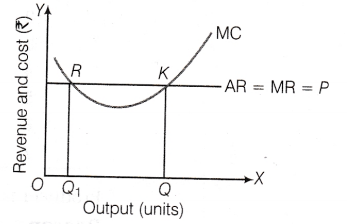According to this approach, the producer is in equilibrium when the Marginal Revenue (MR) is equal to the Marginal Cost (MC) and Marginal Cost curve cuts the Marginal Revenue curve from below. Two conditions under this approach are:
(i) MC = MR
(ii) MC curve should cut the MR curve from below.
MR is the addition to Total Revenue from the sale of one more unit of output and MC is the addition to Total Cost for increasing the production by one unit. The basic aim of every producer is to maximise the profit. For this, a firm compares its MR with its MC.
As long as the addition to revenue is greater than the addition to cost, it is profitable for a firm to continue producing more units of output.
In the above diagram, output is shown on the A-axis, revenue and cost on the 7-axis.
The Marginal curve, is ‘U’ shaped and p = MR= AR.
MC = MR at two points, R and K in the diagram but profits are maximised at point K, corresponding to OQ level of output. Between {{OQ}_{1}}, and OQ levels of output, MR exceeds MC. Therefore, firm will not stop at point R but will continue to take advantage of additional profit. Thus, equilibrium will be at point K where both the conditions are satisfied.
Two other situations may also exist:
(i) MR > MC At output level less than
OQ, MR > MC which implies that firm is earning profit on the last unit of output. The marginal profit provides an incentive to the firm to increase production and move towards OQ units of output. Therefore, when MR>MC, the firm increases output to maximise its profit.
(ii) MR < MC At output level more than
OQ, MR < MC which implies that firm is making a loss on its last unit of output. Hence, in order to maximise profit, a rational producer decreases output as long as MC > MR. Thus, the firm moves towards producing OQ units of output.
